We’re going to talk about all the animals and birds that eat rabbits, we’ll list them and provide some details and information for you.
We all know how cute Rabbits are, right? And they breed very fast; females can give birth to about four to seven baby rabbits at a time – and repeat it every month, especially during the spring season when there’s plenty of food and greenery present.
This all is due to the shorter gestation period of the female rabbit which consists of about 28 days.
Despite all of these characteristics, the population of rabbits is controlled by mother nature (isn’t everything!) – with the help of her many predators.
Rabbits have many predators because they actually don’t have much of a defense mechanism, which makes them easy prey, Mother Nature has compensated Rabbits by enabling them to breed rapidly.
So their list of predators is very long. Here we’ll dive into the most common predators of rabbits. Either read on or watch the video further below from the Ranger Planet YouTube channel.
Fox
The first animal that springs to mind is likely to be a fox. Rabbits are one of the main food sources for foxes. Like the Red fox which is the most common of the fox breeds. Foxes have adapted to most environments, like woods and forests, fields, and agricultural lands. Dunes, salt marshes, peat bogs, mountains, and has become particularly adapted to survive and flourish in urban areas.
Rabbit is a staple food for the fox, but a Fox will change its diet according to the environment they’re in. There are also other Foxes like the Arctic Fox, Fennec Fox, Kit Fox, and Swift Fox, etc. All these subspecies of Foxes will eat rabbits – according to their environment.
Keep in mind that rabbits are not necessarily required for Foxes’ survival, but they can be a large and staple part of their diet.
Here’s what foxes eat. And you can also check what arctic foxes eat.
Also, you might be interested in 34 Quick Facts About Fennec Foxes, Amazing Desert Fox Facts
Wolf
Wolves are carnivores, so they will eat a variety of different animals, in fact, the average wolf will eat about 20 pounds in weight per day.
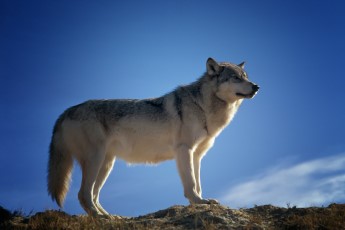
They usually depend upon large ungulates and occasionally small mammals and small ungulates (like a grey wolf), however, rabbits are also a part of their diet.
They eat rabbits mainly as a supplement with their primary food source. They can eat rabbits as a primary source of food during times of food shortages when no larger animals are available.
However, in Minnesota, the rabbit is one of the primary sources of food for wolves – after white-tailed deer.
Here’s the list of What Wolves Eat?. You might also be wondering if wolves mate for life.
Dingo
Dingoes are wild dogs present in Australia. By most accounts. The Dingo species was probably introduced to Australia around 4000 years ago. The Dingo is an opportunistic carnivore and rabbit is definitely a staple source of food for them.
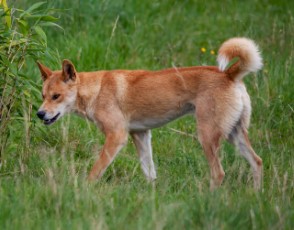
They’re distributed all over Australia beyond the famous dingo fence, and of the many areas where you’ll find them woodlands, grasslands and rocky terrain are their favorite habitats, partly because they can find rabbits and other small prey in more ready abundance.
Dingos hunt mainly in packs for larger game animals but for a rabbit, an individual dingo is easily enough.
Are there wolves in Australia?
Lynx
Lynx live all over Alaska, the southern parts of Washington, and most of Canada. They are medium-sized predatory cats also known as “bobcats”. They love to live deep in coniferous forests like in rocky areas, bogs, and swamps. Snowshoe rabbits (most commonly known as snowshoe hare) form 75% part of their diet.
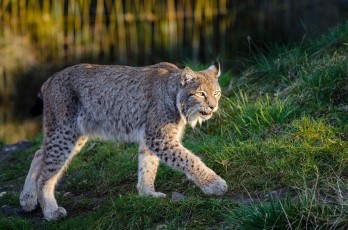
As they live in northern areas where there are fewer opportunities for hunting, so, they prey on rabbits that are present in that area.
They can climb trees and usually work using a ‘sit-and-wait’ strategy for hunting as they are solitary hunters.
However, a mother lynx and her young ones will hunt together once the young are capable, and rabbits are a good starting point to teach the young. Occasionally, a Lynx stores its leftovers by covering them with snow – for later use.
Ocelot
Ocelot is found in Southwestern parts of North America like Arizona, Texas, and most parts of central and south America.
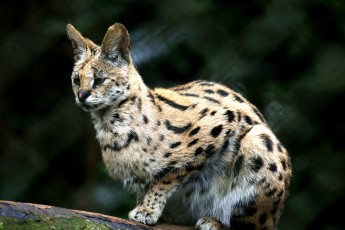
Ocelots love to live in dense forests so they are generally found in rainforests, savanna, thorn forests, and mangrove swamps.
They’re solitary hunters but occasionally hunt with other ocelots. They belong to the cat family so, they can easily prey on a rabbit.
Rabbit is one of the main sources of food for Ocelots, but they can change their menu according to season.
Cat
Big cats are pure carnivores and have a specific diet. They eat only meat and related things. Due to their big size and a large number of members in their pack, they generally hunt larger mammals.
However, cats like lions and tigers can eat rabbits – but more as a snack between meals! It should be kept in mind, that big cats like lions do not generally eat rabbits as a permanent source of food, they only eat them as a meal or a snack and they can also hunt them during food shortages.
The other cats that are solitary hunters and are of smaller size like a cheetah, cougar, etc. can and will all eat a rabbit as a meal too (but only as one meal). This is because of its small size.
Here’s what lions eat.
Coyote
Coyotes can be scavengers as well as hunters, and so are not overly choosy about their food. They can eat almost everything they can get. Contrary to traditional thinking (i.e. they are carnivores) coyotes are omnivores. Most of their meat diet consists of small mammals like rabbits, rodents, etc.
They can eat rabbits when they are available, so we can say that they do not rely upon rabbits – but rabbits form a part of their diet.
Coyotes are found in plains, forests, mountains, and deserts of Canada, the United States, Mexico, and Central America. They can survive in tropical areas too. They are usually solitary creatures but may hunt in packs for a larger animal.
Here are 22 Quick Facts About Coyotes You Need to Know, Coyote Facts!
Wolverine
Wolverines resemble small bears, but they’re the largest member of the weasel family (Mustelidae). They’re omnivore mammals and also known as ‘skunk bears’, ‘carcajous’, or ‘gluttons’. They are equally distributed throughout the northern hemisphere in Asia, Europe, and America.
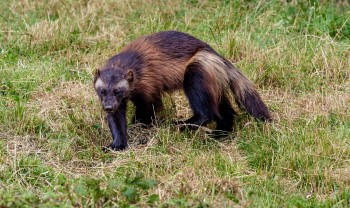
Their favorite habitats include boreal forests, taiga, and tundra. As they are omnivores, they can eat most things.
However, they usually meet their meat requirements from small mammals like rabbits, they can also dig into the burrows of rabbits.
However, in the winter season when there’s a shortage of food they’ll even scavenge, and that includes eating the corpses of small or large animals. They have also been known to dig into the burrow of hibernating mammals in winter to eat them. So we can say that rabbits are a major part of a Wolverine diet, but they’re not necessary for its survival.
Ferret
Ferrets are small obligate carnivores. They are nocturnal so, they sleep in the daytime and hunt at night. They also have very proficient eyesight and hearing as well as a highly developed nose to smell.
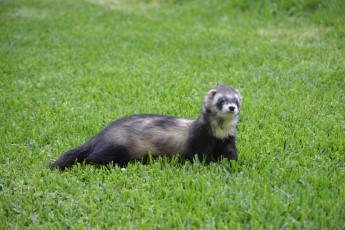
Rabbits are one of the main sources of food for Ferrets in the wild. They not only kill and eat rabbits but they also hunt other small creatures like rats, possum, hedgehogs, and small birds, etc. They use their burrows as shelter from large predators.
They eat every portion of meat – even including the bones, this is because they have a high metabolic rate and have small intestines. The basic consumption of meat for a ferret is about 50 to 70 grams per day.
Weasel
The weasels are carnivores and the smallest member of the Mustelid family and also the smallest carnivores in the World. They are found in North Africa, North America, and Asia but most commonly found in central and Western Europe.
They were also introduced to New Zealand. Like other family members, they also prey on rabbits; rabbits are one of the most common sources of food for Weasels.
Despite their smaller size, they can easily prey upon a cottontail rabbit or other creatures of similar size due to their strength or pack hunt. They eat their victims by crushing their heads or spinal cord from the neck region. They have a high metabolic rate and can eat up to 40% of their body weight in a single day.
Here’s what minks eat.
Badger
It might seem strange to hear that Badgers can eat rabbits – but they do. Although most of their food consists of small insects and worms they can also eat small mammals like rabbits.
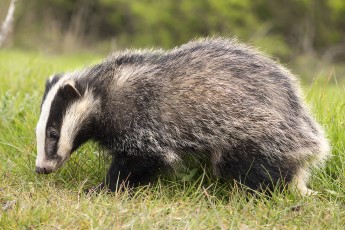
Badgers are omnivores and are found in many areas of the world, you can generally find them in woods, quarries, rural land, and moorland.
Stoat
Like badgers, stoats that are their close family members can also eat rabbits. They can even trick a rabbit – and then prey on it. This diversion strategy involves one of their pack members diverting the rabbit’s attention toward it through some strange behavior, while the other stoats then prey on the distracted Rabbit.
Raccoon
Raccoons are native to North America but now they’re also found in many countries because they were introduced to many parts of the globe during the 20th century.
Raccoons are omnivorous and opportunistic predators. They usually eat plant food but they can eat meat too. Rabbits form part of their diet, however, they prefer slow-moving creatures. That’s why rabbits don’t form a much larger part of their diet.
One question you might be wondering is do raccoons attack humans.
Bear
Bear’s diet varies to a large extent, they can eat anything from honey, to ants, to deer – to people! and even vegetation. Their food intake depends upon the species and the season.
Polar bears usually prefer seafood and Rabbits are more scarce in the arctic region, so they’re less likely to find Rabbits to prey on, they do prey on other small to medium-sized mammals.
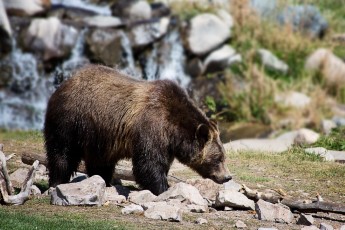
On the other hand, the Grizzly Bear which is notorious for its potential to attack humans, can and will eat everything available to it in its area.
They can even fill their diet with up to 90% vegetation if a meat source is not available, however, they prefer meat when available and small mammals like rabbits would and could be a part of that. In meat terms they prefer fish.
For the Asian bear, the diet is almost the same as other bears – except Fish! And a rabbit is certainly something an Asian Bear would predate.
Even Polar Bears are known to eat Rabbits as there are Rabbits in the arctic tundra.
Eagle
Eagles come in many different types, but the golden eagle and bald eagle are often associated with eating Rabbits as part of their diet. Although fish form a large part of a Bald Eagles diet, of which they consume 70% to 90% fish in their diet, but they can and do eat rabbits too.
Golden eagles generally live in remote areas, often with a large hunting radius and this often includes lush green land where Rabbits are in abundance. So definitely, Golden Eagles prey on Rabbits. In fact, a Rabbit is a very easy and simple meal for most Eagles and other birds of prey like Falcons and Kestrels.
Owl
Owl varies in size from species to species and this means that their diet does too. Owls are nocturnal and rely upon their amazing night vision and their keen sense of hearing to hunt.
Many of them are ‘sit-and-wait’ predators, meaning they will sit silently for a long time in an advantageous spot and wait for prey to pass within the scope of their vision. As soon as an unfortunate rabbit (or other mammals) pass within their field of vision they will swoop in to attack it – using their sharp talons to grab the prey and launch back into the air.
Owls are found all over the world from Australia to Alaska. most of the victims of the Owl are small mammals, and they usually hunt mammals that are smaller than their own size, for many Owls species, rabbits fall under this category.
Small owls like screech owls can prey on baby rabbits while large owls like a barn owl, barred owl, hawk-owl, and the great horned owl can easily capture an adult rabbit. Not only that, but rabbits are one of the basic food sources for the great horned owl.
Hawk
Like the Eagle, a Hawk has a large variety of species under his diet category, let’s take the Red-Tailed Hawk as a typical example and encompass the Red-shouldered hawk and Cooper’s hawk too.
As their name suggests, ‘red-tailed has a red tail and ‘red-shouldered has red shoulders. Hawks mainly feed on birds and small mammals – exactly like rabbits, as well as squirrels, and mice.
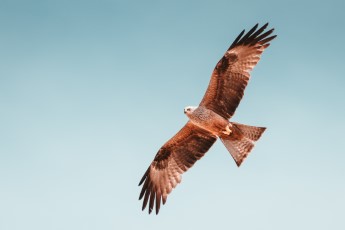
Hawks are more unique than their other family members as they fly near the ground when scanning for food.
There’s also a choice difference for different genders, males prefer birds, while females prefer mammals. However, the rabbit is a part of the diet for both genders and all species. The cottontail rabbit is the main source of food for cooper’s hawk.
Crow
Crows are usually not considered predators, but they’re opportunist feeders of small birds and small animals. So while they mainly scavenge, they sometimes do actively hunt their prey – like baby rabbits.
Snake
Snake is one of the animals that can – and will eat just about anything that moves. There’s a wide variety of snakes from the smallest Barbados (the thread snake) to the largest which is the anaconda.
As they can eat pretty much everything, their diet depends upon their physical size. Snakes like python, boa, and anaconda can easily eat a rabbit, however, cobra, mamba, viper, and rattlesnakes, for example, could potentially eat a small rabbit although naturally, their mouth is smaller.
Larger snakes can easily engulf a rabbit as a whole, while smaller snakes do this job with the help of their independent “moving” mandibles (meaning independent upper and lower jawbones). They will predate rabbits when they are available on the menu, however, they can eat most prey.
Lizard
Reptiles like Lizards will prey on rabbits. As we know a Lizard’s food range can be very diverse and like Toads, they’ll eat whatever they can get. Rabbits are part of a Lizard’s diet.
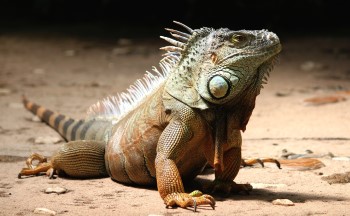
The diet of a lizard naturally depends upon its size. Larger Lizards like Iguanas and Komodo Dragons which are the largest lizards can eat most things from rabbits to small deer.
The Monitor lizard, which is a ‘medium-sized’ lizard eats rabbits as one of its main sources of food.
Lizards are found throughout the world, but most of their species are found in Eastern Europe and Asia.
Human
Last but not least, Humans.
There are many tribes of humans that have been hunting rabbits in the wild for thousands of years, tribes and trappers from all over the world.
Along with these tribes, many modern hunters also hunt rabbits. They not only kill rabbits to eat but also for furs. In the modern age, there are thousands of rabbit farms across the globe that are fulfilling the demand for rabbit meat in the world.
That’s quite a list, and there are many more species and subspecies that predate Rabbits. Here’s a long list of the animals that eat Rabbits…
Rabbit Predators Quick List
- Fox
- Wolf
- Dingo
- Lynx
- Ocelot
- Cat
- Coyote
- Cat
- Coyote
- Wolverine
- Ferret
- Weasel
- Badger
- Stoat
- Raccoon
- Bear
- Eagle
- Owl
- Hawk
- Crow
- Snake
- Lizard
- Human
Resources
If you’re considering keeping Rabbits as pets, then here are a couple of resources from Amazon that will help you in understanding more about how to raise Rabbits to enjoy them as Pets. Or to immerse yourself in Rabbit culture even more.
The Everything Pet Rabbit handbook
It’s said to be good luck to carry a Rabbit’s foot as a symbol. Here’s the one we’ve selected from Amazon, we hope it brings you good fortune!
Real Rabbit Fur Rabbits Foot Keychain
So Finally…
We hope this list has helped you understand what eats rabbis. If you’re keeping Rabbits as a Pet, then when outside just make sure they’re in a secure place and/or supervised to avoid any predators local to you.
